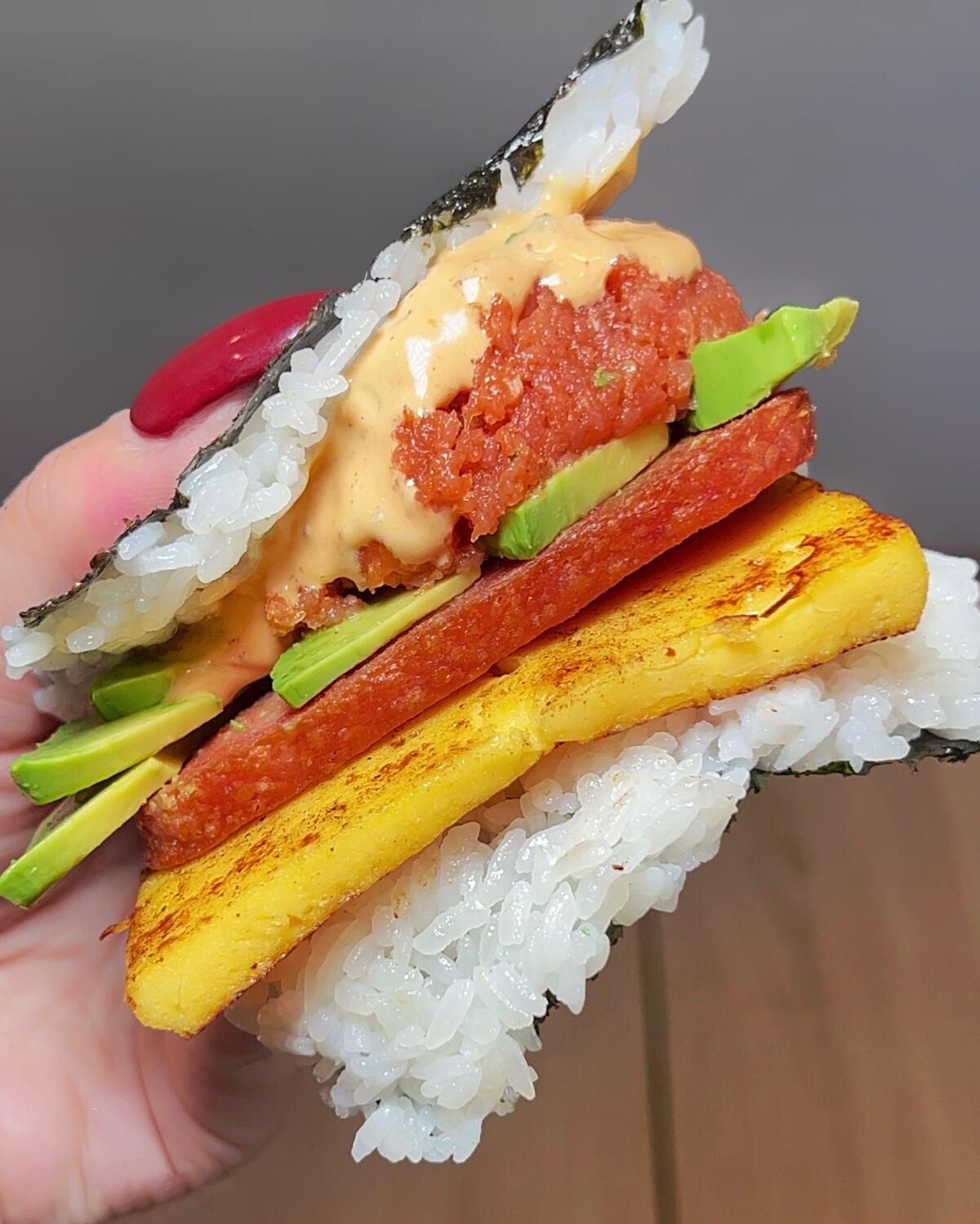I can't stop eating in Koreatown. As my fingers run across the keyboard, I anticipate angry emails from readers across the valleys (I'm listening to you, San Fernando Valley) and beyond. I promise there will soon be more columns dedicated to wherever you live. But if you're like me and use 6th Street or Olympic Boulevard as main arteries between East and West Los Angeles, you'll be spending a lot of time in Koreatown.
And with a near-constant influx of new restaurants, tea and dessert shops, I've always found this culinary and cultural wonderland irresistible.
During one of my recent walks around town, I noticed Supamu, the restaurant that replaced spicy fried chicken specialist Michin Dak on the corner of 6th and South Catalina streets. It's more of a stall than an actual restaurant and serves about 20 versions of what it calls Okinawan-style onigiri.
Choose your own Spam adventure in Supamu
“We wanted to do something quirky and fun with Spam,” owner Young Kim said in a recent call. “Our main ingredients are spam and tamago.”
Onigiri is presented as a kind of sandwich stacked against the more traditional rice ball that envelops a filling. They are similar to onigirazu, the plastic-wrapped sushi sandwiches that originated in the “Cooking Papa” manga series in the 1990s. And with the inclusion of Spam, they are more reminiscent of Spam musubi, the popular Hawaiian food consisting of Spam and rice with a band of toasted seaweed.
Each Supamu onigiri includes two layers of nori-wrapped sushi rice, a slice of fried or deep-fried Spam, a square of Japanese sweet omelette, and about two dozen other possible fillings.
Kim is not a chef, but has worked in the Japanese restaurant industry in Los Angeles for the past 20 years, primarily handling real estate and investments. He left the corporate sector a few years ago to open Ramen Kenjo in USC Village and Bopjo KBBQ in San Diego.
A Spam musubi curry croquette from Supamu in Koreatown.
(Cristina Ng)
When a friend returned from a trip to Okinawa with photos and stories of Okinawan rice sandwiches, Kim was determined to recreate them in Los Angeles.
“When people ask me if I'm a chef, I tell them I'm a businessman who has to cook,” he said. “I am not a trained chef. I like to have fun and do things out of the ordinary, nothing ordinary.”
He founded Supamu from a ghost kitchen in 2020, transitioned to a food truck, and opened the Koreatown brick-and-mortar store in March. With a small accessible window and a few high tables with stools, it's an unlikely place for glorification.
The picture menu near the ordering window is extensive, with onigiri stuffed with whole soft-shell crabs, takoyaki balls, and kimchi. If you arrive too late, bands of black tape will cover the photographs of spent nigiri.
One is a snack. Two is one meal. After three, you'll probably need to go to bed.
Spicy tuna is like your favorite bagel and musubi mashed into one. The ground tuna is seasoned with sesame oil and just enough Sriracha to provide a slight sting. Kim places it on top of the spam and tamago with a drizzle of spicy mayonnaise and a sprinkle of furikake. Spicy tuna between spam and egg may be a tough sell, but the flavor, freshness, and temperature of the tuna lighten the sandwich, fooling you into thinking you have enough room to eat more than you previously thought possible.
The most luxurious of onigiri may be the one filled with an entire soft-shell crab, its claws sticking out at all angles. Kim dips the crabs in a potato starch batter, deep-fries them, and then dresses them with a soy-garlic sauce. They are nestled between the top layer of rice and spam, providing a crunchy, sea-infused layer.

Spicy tuna Spam musubi from Supamu in Koreatown.
(Cristina Ng)
If I had to choose a favorite, the one that I would order two to eat one on the spot and the other 30 minutes later in the car, it is the curry croquette. Depending on when you visit and whether Kim is experiencing supply chain issues at the time, the croquette in the middle of your onigiri can be pumpkin, pumpkin and potato, potato, or corn. Whatever the starch, it is seasoned with a mild, sweet Japanese curry and made into a fritter. I could have feasted on just a basket full of my recent pumpkin and potato fritters.
The onigiri is assembled with the croquette and a pile of sesame coleslaw and your choice of tonkatsu or tartar sauce.
Kim said onigiri are, by design, infinitely customizable. If you don't eat pork, there is turkey spam. If you like sweet Spam, order the maple Spam. Do you enjoy extra crispy edges of your Spam? Ask them to fry it. If you follow a plant-based diet or don't like spam, you can replace it with miso-marinated tofu. Do you hate algae? Instead, you'll wrap your rice in soy paper.
Kim said he plans to add even more onigiri to the menu and expand hours on weekends.
I'll have my Spam fried and topped with whatever combination Kim dreams up next.











